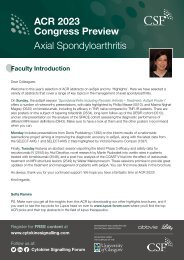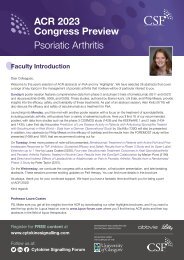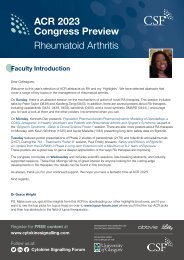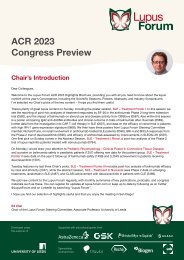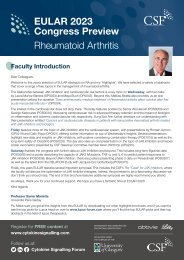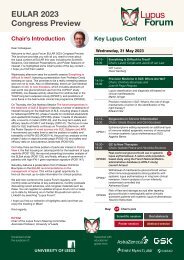ACR Congress Review 2019
You also want an ePaper? Increase the reach of your titles
YUMPU automatically turns print PDFs into web optimized ePapers that Google loves.
Individual and composite measures of disease activity in patients with RA treated with upadacitinib or<br />
comparators were presented by van Vollenhoven and colleagues. The analyses included patients who<br />
were MTX naïve (SELECT-EARLY, n=947) or MTX-IR (SELECT-COMPARE, n=1629). Responses at<br />
Week 12 were defined as ≥50% improvement in the 7 components of the <strong>ACR</strong> response criteria. In<br />
MTX-naïve and MTX-IR patients, treatment responses at 12 weeks occurred in significantly higher<br />
proportions of patients receiving upadacitinib monotherapy versus MTX and upadacitinib plus MTX<br />
versus placebo for all 7 components of the <strong>ACR</strong> response criteria, and for 5 of 7 <strong>ACR</strong> components for<br />
upadacitinib plus MTX versus adalimumab plus MTX. Favourable outcomes with upadacitinib treatment<br />
were evident both in composite and individual parameters [523].<br />
Kremer and colleagues presented the comparative efficacy of upadacitinib in combination with MTX<br />
versus upadacitinib in combination with other csDMARDs. Analyses were performed using data from the<br />
SELECT-NEXT and SELECT-BEYOND trials, in which 535 and 410 patients, respectively, received<br />
concomitant MTX (mean dose 17 mg/week), and 124 and 82 patients received non-MTX csDMARDs.<br />
Across all subgroups, the proportion of patients achieving efficacy outcomes was higher with both<br />
upadacitinib doses compared with placebo. There were no significant differences between efficacy<br />
outcomes with upadacitinib in combination with MTX versus upadacitinib in combination with non-MTX<br />
csDMARDs in either patient population; this included <strong>ACR</strong>20 response as well as LDA and remission<br />
defined by DAS28-CRP and CDAI. In summary, the efficacy of upadacitinib in patients with RA<br />
appeared comparable whether administered in combination with MTX or non-MTX csDMARDs [524*].<br />
Hall and colleagues presented remission rates in patients with RA treated with upadacitinib or<br />
comparators. The analyses included patients who were MTX naïve (SELECT-EARLY, n=945), MTX-IR<br />
(SELECT-COMPARE, n=1629) and bDMARD-IR (SELECT-BEYOND, n=498). At 12 weeks, in<br />
SELECT-EARLY and SELECT-COMPARE, a significantly greater proportion of patients receiving<br />
upadacitinib 15 or 30 mg QD achieved remission by all four definitions versus MTX, placebo or<br />
adalimumab. In SELECT-BEYOND, (a refractory population many of whom had an inadequate response<br />
to multiple bDMARDs), a significantly greater proportion of patients receiving upadacitinib 30 mg<br />
achieved all remission definitions versus placebo within the first 12 weeks and rates of remission further<br />
increased through Week 24 for both dose groups. All disease activity components of each remission<br />
definition were significantly improved in patients receiving upadacitinib compared to MTX or placebo,<br />
and all Boolean components were significantly improved in patients receiving upadacitinib 15 mg<br />
compared with adalimumab [529].<br />
An evaluation of structural joint damage progression through Week 48 in patients with moderately to<br />
severely active RA treated with upadacitinib monotherapy or in combination with MTX was presented by<br />
Peterfy and colleagues. The analysis included patients from SELECT-EARLY (n=945) and<br />
SELECT-COMPARE (n=1629). At Weeks 24/26, upadacitinib as monotherapy and in combination with<br />
background MTX significantly inhibited radiographic progression (measured by mean ΔmTSS) and the<br />
proportion of patients with no radiographic progression versus MTX and placebo, respectively. The<br />
significant inhibition of radiographic progression with upadacitinib was maintained through Week 48<br />
versus MTX in SELECT-EARLY and versus placebo in SELECT-COMPARE. Following the switch of all<br />
placebo patients to upadacitinib in SELECT-COMPARE by Week 26, no further change in mean mTSS<br />
was observed through Week 48. In summary, upadacitinib both as monotherapy, and in combination<br />
with background MTX, was effective in inhibiting the progression of structural joint damage through<br />
Week 48 in MTX-naïve, and MTX-IR patients, respectively [547*].<br />
Fleischmann and colleagues presented outcomes associated with a treatment switch from upadacitinib<br />
to adalimumab and vice-versa among MTX-IR RA patients who were non-responders or partial<br />
responders in a Phase 3 study of upadacitinib 15 mg QD versus placebo or adalimumab 40 mg injection<br />
EOW. Of the 651 and 327 patients randomised to receive upadacitinib and adalimumab, 39% were<br />
switched from upadacitinib to adalimumab and 49% were switched from adalimumab to upadacitinib.<br />
*Chairman’s Pick



